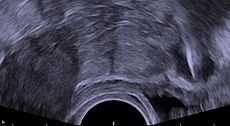Foreign body granuloma
| Foreign body granuloma | |
|---|---|
 Transvaginal ultrasonography showing a foreign body granuloma at right as a hypoechoic (dark) area around a perforated intrauterine device. The uterus is at left. | |
| Classification and external resources | |
| ICD-10 | L92.3 (ILDS L92.300) |
The foreign body granuloma is a response of biological tissue to any foreign material in the tissue.[1] Tissue-encapsulation of an implant is part of this. An infection around a splinter is part of this, too.[2]
The presence of the implant changes the healing response, and this is called the foreign-body reaction (FBR). FBR consists of: protein adsorption, macrophages, multinucleated foreign body giant cells (macrophage fusion), fibroblasts, and angiogenesis.
It can be caused by beryllium.[3]
See also
References
- ↑ Rapini, Ronald P.; Bolognia, Jean L.; Jorizzo, Joseph L. (2007). Dermatology: 2-Volume Set. St. Louis: Mosby. p. 1443. ISBN 1-4160-2999-0.
- ↑ Biomaterials Science Second edition, Ratner et al. Pp. 296-304
- ↑ Haley PJ (1991). "Mechanisms of granulomatous lung disease from inhaled beryllium: the role of antigenicity in granuloma formation". Toxicologic pathology 19 (4 Pt 1): 514–25. doi:10.1177/019262339101900417. PMID 1813991.
| ||||||||||||||||||||||||||||||||||||||||||||||||||||||||||||||||
